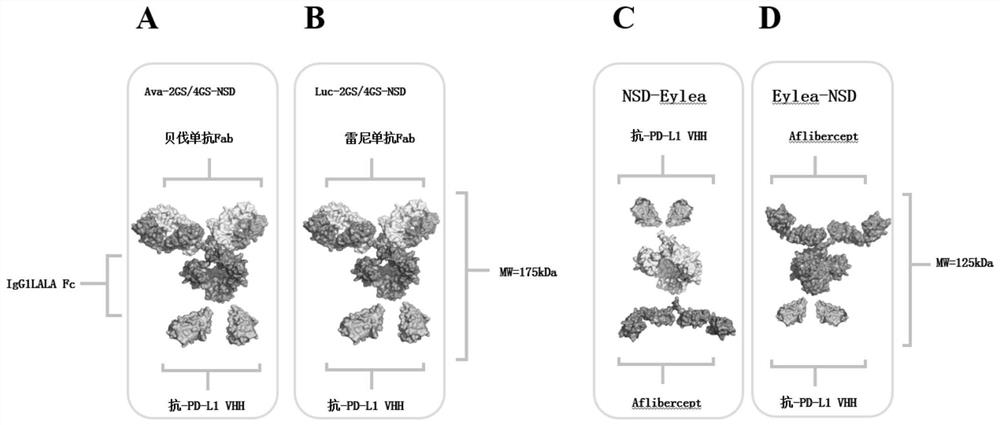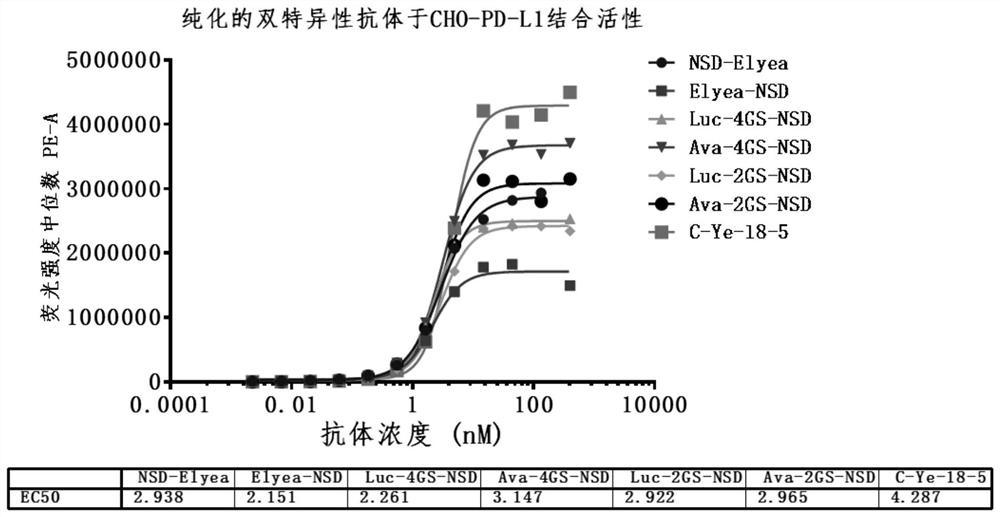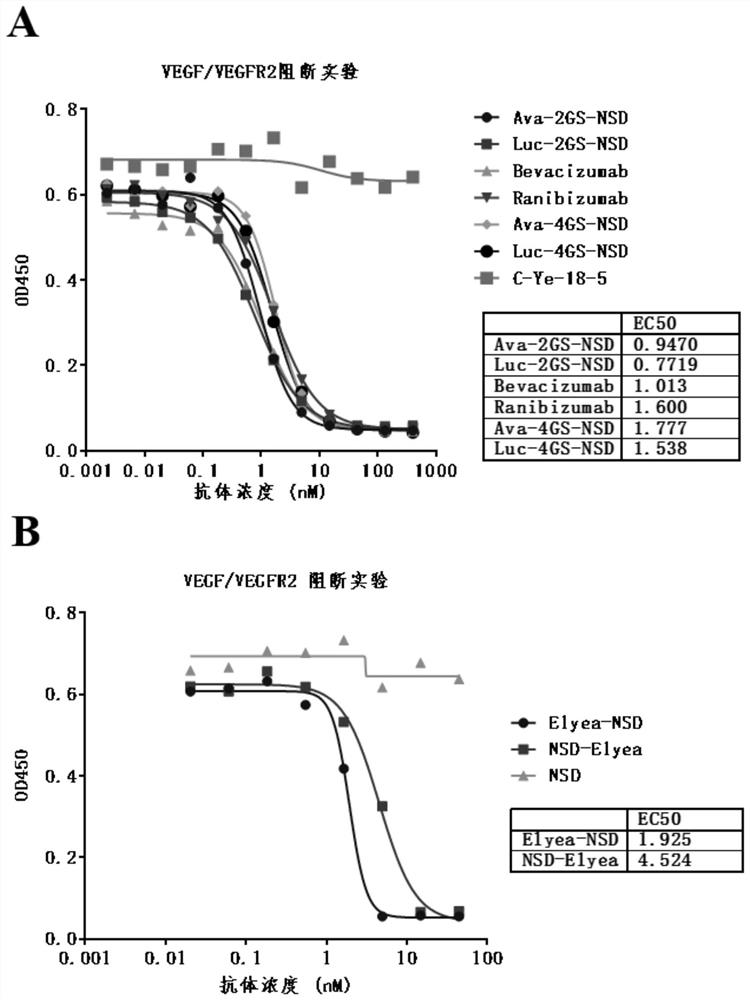Anti-VEGF/PD-L1 bispecific antibody and application thereof
A bispecific antibody, PD-L1 technology, applied in the field of biomedicine, can solve the problems of evaluation model, low expression level, large difference in quality control, etc., and achieve good thermal stability
- Summary
- Abstract
- Description
- Claims
- Application Information
AI Technical Summary
Problems solved by technology
Method used
Image
Examples
Embodiment 1
[0227] Example 1: Cloning and expression of anti-VEGF / PD-L1 bispecific antibody
[0228] 1.1 Antibody structure design
[0229] In this example, six anti-VEGF / PD-L1 bispecific antibodies were constructed, namely:
[0230] Ava-2GS-NSD / Ava-4GS-NSD: composed of 2 polypeptide chains, the schematic diagram of its structure is as follows figure 1 As shown in A, the peptide chain #1 has the amino acid sequence shown in SEQ ID NO: 1 or SEQ ID NO: 2, which includes the VH amino acid sequence derived from the anti-VEGF antibody Bevacizumab (Patent No.: WO1998045332) (SEQ ID NO:3), the C-terminus of the VH amino acid sequence is directly connected to the CH amino acid sequence derived from human IgG1 (introducing LALA mutation to reduce the Fc function, SEQ ID NO:4), and the anti-PD-L1 Nanobody C - The N-terminal of Ye-18-5 (patent application number: 2019108631090) (SEQ ID NO: 5) passes through 11 amino acid residues (G 4 S) 2 G (SEQ ID NO:6) (Ava-2GS-NSD) or 21 amino acid residues ...
Embodiment 2
[0236] Example 2: Determination of antibody affinity for bispecific antibodies
[0237] ForteBio affinity determination was performed according to the existing method (Estep, P et al., Solution-based measurement of high-throughput antibody-antigen affinity and epitope fractionation, MAbs, 2013.5(2):p.270-8). Briefly, the sensor was equilibrated offline for 30 min in the assay buffer, then measured online for 60 s to establish a baseline, and the purified antibody obtained as described above was loaded onto the AHC sensor online. Then put the sensor into 100nM PD-L1 or VEGF antigen for 5 minutes, and then transfer the sensor to PBS for 5 minutes to dissociate. Analysis of kinetics was performed using a 1:1 binding model.
[0238] Table 1. Binding affinity of candidate molecules and PD-L1
[0239] Numbering KD(M) Kon(1 / Ms) Koff(1 / s) Ava-2GS-NSD 8.48E-09 3.19E+05 2.70E-03 Luc-2GS-NSD 9.52E-09 2.81E+05 2.67E-03 Ava-4GS-NSD 7.12E-09 3.54E+05...
Embodiment 3
[0243] Example 3: Binding of purified bispecific antibodies to PD-L1
[0244] CHO cells overexpressing human PD-L1 (CHO-hPD-L1 cells) were generated by transfecting pCHO1.0 vector (purchased from Invitrogen) cloned into MCS of human PD-L1 cDNA (purchased from Sino Biological). Adjust the cell density of the expanded CHO-hPD-L1 cells to 2×10 6 Cells / ml, 100 μl / well was added to a 96-well flow plate, and centrifuged for later use. Dilute the purified PD-L1 antibody with PBS, start at 400nM and start 3-fold dilution for a total of 12 points. Add 100 μl / well of the above-mentioned diluted sample into the above-mentioned 96-well flow plate with cells, incubate at 4°C for 30 minutes, and wash with PBS twice. Goat F(ab')2 anti-human IgG-Fc (PE) (purchased from Abcam) diluted 100 times with PBS was added to 100 μl / well, incubated at 4°C for 30 min, and washed twice with PBS. Add 100 μl / well of PBS to resuspend the cells, detect on CytoFlex (Bechman) flow cytometer and calculate the...
PUM
 Login to View More
Login to View More Abstract
Description
Claims
Application Information
 Login to View More
Login to View More - R&D
- Intellectual Property
- Life Sciences
- Materials
- Tech Scout
- Unparalleled Data Quality
- Higher Quality Content
- 60% Fewer Hallucinations
Browse by: Latest US Patents, China's latest patents, Technical Efficacy Thesaurus, Application Domain, Technology Topic, Popular Technical Reports.
© 2025 PatSnap. All rights reserved.Legal|Privacy policy|Modern Slavery Act Transparency Statement|Sitemap|About US| Contact US: help@patsnap.com



